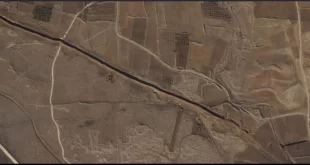
Dec 20, 2013, Consortium News
The New York Times continues to pump up the case blaming the Syrian government for the Sarin attack outside Damascus on Aug. 21, despite the collapse of its earlier front-page indictment based on the now discredited “vectoring” of two rockets which the Times suggested were launched from an elite Syrian military base.
The Times’ “vectoring” argument, which was also pushed by Human Rights Watch in its bid to get the Obama administration to intervene militarily in Syria, has fallen apart for a variety of reasons, including analyses showing that the rockets had much more limited range than the Times assumed; the United Nations’ disclosure that one of the two projectiles struck a building before landing (thus negating the Times’ certainty about its flight path); and the lack of any Sarin or other chemical warfare agents at one of the two sites (leaving only one flight path of a Sarin-laden rocket and thus no intersecting azimuths).
The Times’ front-page “vectoring” article of Sept. 16, thus, represents another major embarrassment for the so-called newspaper of record, similar to other high-profile errors such as the “aluminum tube” story in 2002 which helped clear the way for the Iraq War and the Times’ dismissive reporting on Contra-cocaine trafficking in the 1980s and 1990s although even the CIA’s inspector general later admitted the scandal’s veracity.
Yet, despite the legs having been knocked out from under its “vectoring” story, the New York Times has made no effort to correct the record or even acknowledge the contrary evidence. Instead on Thursday, it ran another dubious story trying to prop up its case against the Syrian regime of Bashar al-Assad.
The new article makes much of the appearance of a chemical called hexamethylenetetramine – or hexamine – in some environmental samples tested by UN inspectors from the Ghouta suburb outside Damascus. Hexamine can be an additive used in the production of Sarin, the deadly nerve gas involved in the Aug. 21 incident, and the Times notes that the Syrian government lists hexamine as a chemical in its stockpile scheduled for destruction.
But if you read far enough into the Times’ article, you will find a passing reference to the fact that hexamine “is also commonly found in heating fuel, as well as in conventional explosives.” In other words, the discovery of trace amounts of the chemical really doesn’t prove anything – as much as the Times labors to suggest otherwise.
The Times’ treatment of this factoid is reminiscent of its hyping of Iraq’s purchase of “aluminum tubes” as suitable for nuclear centrifuges when the tubes more realistically were acquired for production of conventional artillery, a point which the Times buried deep in that article in 2002 and which turned out later to be the actual explanation.
Now, the Times spends half a news page hyperventilating about a chemical which “Could Further Implicate Syria in Chemical Attack, Analysts Say,” while barely mentioning the much more common – and arguably much more likely – innocent explanation that hexamine “is also commonly found in heating fuel.”
Testing All Theories
Still, since we don’t yet know who was responsible for the hundreds of Sarin-related deaths on Aug. 21, one could understand if the New York Times were laying out every possible scenario and running down every possible lead. But that isn’t what the Times is doing. It only highlights evidence that implicates the Assad regime and ignores or dismisses evidence that goes in other directions.
So, while the Times fronted its “vectoring” article and gives half a page to the comments of some analysts about the presence of hexamine, the newspaper leaves out contrary analyses, such as the work of experts computing the maximum range of the crude missiles that supposedly delivered the Sarin on Aug. 21.
The “Who Ghouta” Web site in the United Kingdom has offered a much more balanced treatment of the evidence, noting weaknesses in the claims by the various sides in the dispute, but also featuring scientific experiments gauging the maximum range of the two rockets that the Times used in its “vectoring.”
For the Times’ (and Human Rights Watch’s) analysis to be feasible, the two rockets would have had to have traveled about 9.5 kilometers for the alleged flight paths to have originated at the military base of the 104th Brigade of the Republican Guard, northwest of Damascus, not far from the Presidential Palace.
But the tests showed the rockets had a range of only about 2.5 kilometers. The “Who Ghouta” Web site notes that “the same conclusion was later reached by two experts: Theodore Postol, a Professor at MIT (quoted in the [Seymour] Hersh report), and Richard [Lloyd], a warhead technology consultant (quoted in the Brown Moses blog).”
But there are other disqualifying problems with the “vectoring” claims. For one, the UN inspectors’ report said one of the two missiles — the one striking Moadamiya, south of Damascus – “initially impacted the corner of the second floor of an adjacent apartment building to the east” before cutting through a trellis and crash landing.
So, while the inspectors could compute the angle of the rocket’s final descent, its clipping of the building would make a calculation of its flight path and thus its point of origin highly dubious if not impossible.
There is another big problem with the “vectoring” argument: the UN inspectors found no Sarin and no chemical weapons agents in the 13 sample areas inspected in Moadamiya, while they did find substantial evidence of Sarin in the Zamalka/Ein Tarma area, east of Damascus. But you can’t do a vectoring with only one flight path.
Despite the absence of Sarin and other chemical warfare agents in Moadamiya, victims did show up at the local hospital with symptoms of Sarin poisoning. But the likely explanation – as even the Obama administration’s “Government Assessment” of Aug. 30 suggested – was that victims of the Zalmalka attack spilled over into neighboring areas.
A footnote contained in a White House-released map on the supposed attack locations read: “Reports of chemical attacks originating from some locations may reflect the movement of patients exposed in one neighborhood to field hospitals and medical facilities in the surrounding area. They may also reflect confusion and panic triggered by the ongoing artillery and rocket barrage, and reports of chemical use in other neighborhoods.”
Though the Obama administration’s “Government Assessment” pointed the finger of blame for the Sarin attack at the Syrian government, the four-page white paper provided not a single piece of evidence that could be independently evaluated — which has made the Times’ “vectoring” analysis even more important, as the only significant piece of “hard evidence” cited by the Assad-did-it crowd. So, the actual “softness” of that evidence alters the public debate.
Journalism Standards
Of course, it may turn out that some element of the Syrian military was responsible for the Sarin attack in the Zamalka area. Or perhaps some extremist wing of the Syrian rebels either botched a chemical attack aimed at government targets or engaged in a provocation on a pro-rebel neighborhood to draw the U.S. military into the war against the Assad regime. Or it conceivably was a tragic mistake, the mishandling of a very dangerous payload.
But whatever the eventual answer to the mystery, the New York Times should at least reflect the doubts among many analysts, including some inside the U.S. intelligence community. Instead of stonewalling in defense of its front-page “vectoring” article – much like it did for crucial months in 2002-03 as its “aluminum tube” story contributed to the bloodbath in Iraq – the Times also should acknowledge legitimate questions being raised about the feasibility of its Syria analysis.
There are obvious similarities between the Times’ coverage of Iraq and Syria. In both cases, the country was governed by a “designated” Arab villain, Saddam Hussein in Iraq and Bashar al-Assad in Syria. Both were opposed by the U.S. and Israeli governments and were the targets of neoconservative calls for “regime change.”
Thus, despite the problems with the “vectoring” story, there was very little pushback from authoritative circles that would get the attention of the Times editors. From a career perspective, it was fairly safe to go with the flow of U.S.-Israeli vitriol against the despised leaders. Indeed, some Times editors may see themselves as part of the propaganda apparatus engaged in the worthy goal of getting rid of people like Hussein and Assad.
But that is not how journalism is supposed to work. The job of reporters and editors should be to present the American people and the world public with full and fair coverage of important events – and surely the issue of war or peace in the Middle East qualifies.
The readers of the New York Times should not have to turn to Internet sites to get a balanced treatment of such a crucial story.
[Here is some of our earlier reporting on the Syrian crisis: “A Dodgy Dossier on Syrian War”; “Murky Clues From UN’s Syria Report”; “Obama Still Withholds Syria Evidence”; “How US Pressure Bends UN Agencies”; “Fixing Intel Around the Syria Policy.”]
 Syria Support Movement solidarity with the Syrian people
Syria Support Movement solidarity with the Syrian people




